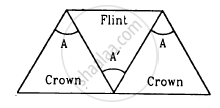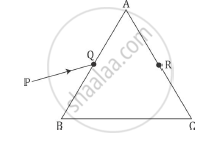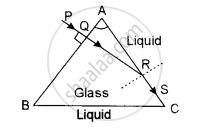Advertisements
Advertisements
प्रश्न
Three thin prisms are combined as shown in figure. The refractive indices of the crown glass for red, yellow and violet rays are μr, μy and μv respectively and those for the flint glass are μ'r, μ'y and μ'v respectively. Find the ratio A'/A for which (a) there is no net angular dispersion, and (b) there is no net deviation in the yellow ray.

उत्तर
For the crown glass, we have:-
Refractive index for red rays = μr
Refractive index for yellow rays = μy
Refractive index for violet rays = μv
For the flint glass, we have:-
Refractive index for red rays = μ'r
Refractive index for yellow rays = μ'y
Refractive index for violet rays = μ'v
Let δcy and δfy be the angles of deviation produced by the crown and flint prisms for the yellow light.
Total deviation produced by the prism combination for yellow rays:-
δy = δcy − δfy
= 2δcy − δfy
=2(μcy + 1)A − (μfy − 1)A'
Angular dispersion produced by the combination is given by
δv − δr = [(μvc − 1)A − (μvf − 1)A' + (μvc − 1)A] − \[\left[ \left( \mu_{rc} - 1 \right)A - \left( \mu_{rf} - 1 \right)A' + \left( \mu_{rc} - 1 \right)A \right]\]
Here,
μvc = Refractive index for the violet colour of the crown glass
μvf = Refractive index for the violet colour of the flint glass
\[\mu_{rc}\] = Refractive index for the red colour of the crown glass
\[\mu_{rf}\] = Refractive index for the red colour of the flint glass
On solving, we get
δv − δr = 2(μvc −1)A − (μvf − 1)A'
(a) For zero angular dispersion, we have:
δt − δt = 0 = 2(μvc −1)A − (μvf − 1)A'
\[\Rightarrow \frac{A'}{A} = \frac{2( \mu_{vf} - 1)}{( \mu_{vc} - 1)}\]
\[ = \frac{2( \mu_r - \mu_r )}{( \mu_r - \mu)}\]
(b) For zero deviation in the yellow ray, δy = 0.
⇒ 2(μcy − 1)A = (μfy − 1)A
\[\Rightarrow \frac{A'}{A} = \frac{2( \mu_{cy} - 1)}{( \mu_{fy} - 1)}\]
\[ = \frac{2( \mu_y - 1)}{(\mu '_y - 1)}\]
APPEARS IN
संबंधित प्रश्न
A ray PQ incident on the face AB of a prism ABC, as shown in the figure, emerges from the face AC such that AQ = AR.

Draw the ray diagram showing the passage of the ray through the prism. If the angle of the prism is 60° and refractive index of the material of prism is `sqrt3` , determine the values of angle of incidence and angle of deviation
A ray of light passes through an equilateral glass prism such that the angle of incidence is equal to the angle of emergence and each of these angles is equal to 3/4 of angle of prism. Find the angle of deviation.
What is the cause of dispersion of light
State any two difference between the primary rainbow and secondary rainbow
For any prism, prove that :
'n' or `mu = sin((A + delta_m)/2)/sin(A/2)`
where the terms have their usual meaning
Give the formula that can be used to determine refractive index of materials of a prism in minimum deviation condition ?
The equation \[\omega = \frac{\mu_u - \mu_r}{\mu - 1}\] was derived for a prism having small refracting angle. Is it also valid for a prism of large refracting angle? Is it also valid for a glass slab or a glass sphere?
If a glass prism is dipped in water, its dispersive power ___________ .
A prism can produce a minimum deviation δ in a light beam. If three such prisms are combined, the minimum deviation that can be produced in this beam is _______________.
A certain material has refractive indices 1.56, 1.60 and 1.68 rfor red, yellow and violet lightespectively. (a) Calculate the dispersive power. (b) Find the angular dispersion produced by a thin prism of angle 6° made of this material.
The minimum deviations suffered by, yellow and violet beams passing through an equilateral transparent prism are 38.4°, 38.7° and 39.2° respectively. Calculate the dispersive power of the medium.
Two prisms of identical geometrical shape are combined with their refracting angles oppositely directed. The materials of the prisms have refractive indices 1.52 and 1.62 for violet light. A violet ray is deviated by 1.0° when passes symmetrically through this combination. What is the angle of the prisms?
The deviation produced for violet, yellow and red lights for crown glass are 3.75°, 3.25° and 2.86° respectively. Calculate the dispersive power of the crown glass.
In a regular prism, what is the relation between angle of incidence and angle of emergence when it is in the minimum deviation position?
Calculate dispersive power of a transparent material given : nv = 1.56, nr = 1.54, ny = 1.55.
A narrow beam of monochromatic light, PQ, is incident normally on one face of an equiangular glass prism of refractive index 1.45. When the prism is immersed in a certain liquid, the ray makes a grazing emergence along the other face (See figure). Find the refractive index of this liquid. 
What is meant by the dispersive power of transparent material?
An equilateral glass prism has a refractive index 1.6 in the air. Calculate the angle of minimum deviation of the prism, when kept in a medium of refractive index `4sqrt(2)"/"5.`
